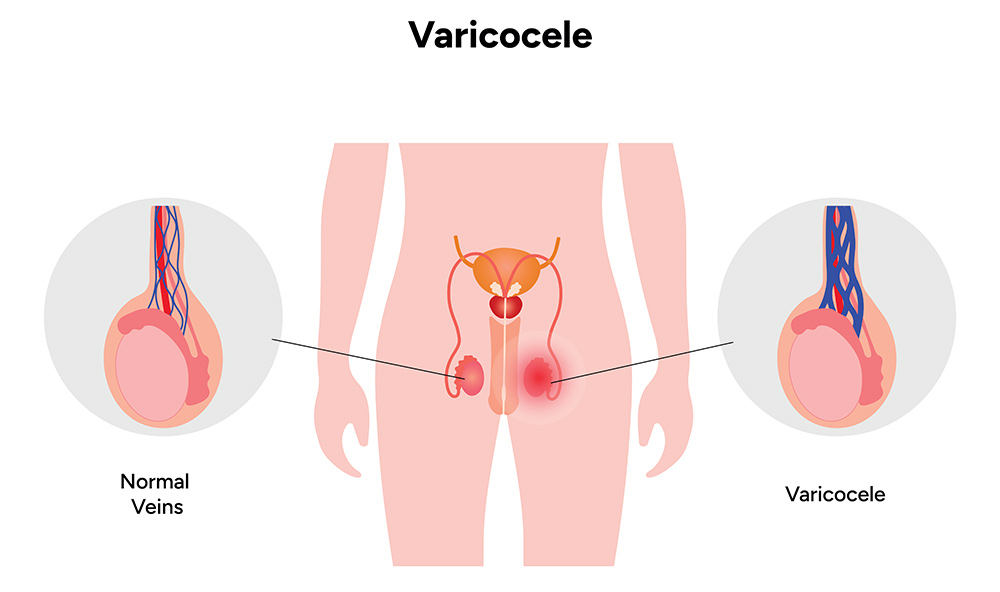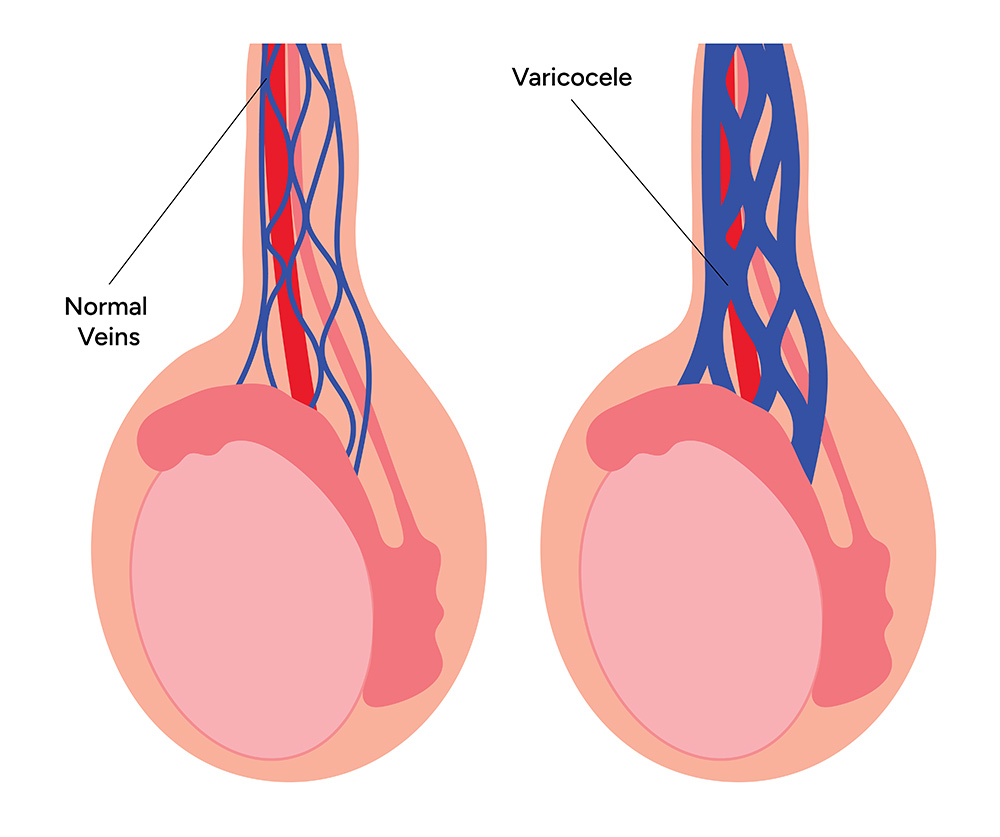Table of Contents
ToggleLast updated on September 9, 2025
Testicular discomfort and swelling can be a distressing experience for any man, especially when it interferes with daily activities or reproductive health. One of the most common causes of these symptoms is a varicocele, a condition characterised by the enlargement of veins within the scrotum, much like varicose veins in the legs.
Although varicocele may not always produce noticeable symptoms, it can affect fertility, testicular function, and overall wellbeing. In some cases, it is only discovered during routine examinations or when investigating challenges related to conception. For others, it can cause a dull ache, heaviness, or visible changes in the scrotal area.
At Vein Doctors Sydney, we recognise the importance of understanding and managing this condition early. In this article, we’ll explore what a varicocele is, the difference between a varicocele vs normal anatomy, what causes a varicocele, the symptoms to look out for, and treatment options available for those affected.
What Is a Varicocele?
A varicocele is the enlargement of veins in the scrotum, specifically within a group of veins called the pampiniform plexus. These veins are responsible for draining blood from the testicles. When the valves in these veins weaken or fail, blood begins to pool and causes the veins to become dilated.
The condition most commonly affects the left side due to anatomical differences in venous drainage, but it can also occur on both sides. Varicoceles typically develop during puberty and may progress over time. While some men remain symptom-free, others experience discomfort, testicular changes, or issues with fertility.
Varicoceles are present in roughly 15% of the general male population, but they are found in up to 40% of men experiencing infertility. This makes early detection and proper management essential for long-term reproductive health.
What Causes Varicocele?
Varicoceles are caused by faulty valves within the veins that prevent blood from flowing efficiently. When these valves fail, blood pools in the veins, leading to their enlargement. This process is similar to the development of varicose veins in the legs.
Several factors may contribute to this condition. The anatomy of the left testicular vein makes it more susceptible due to its angle and drainage into a larger vein with higher pressure.
Hormonal imbalances, prolonged standing, or activities that increase abdominal pressure may also play a role. In some cases, varicoceles are influenced by hereditary factors, especially if there is a family history of varicose veins or vein disorders.

Symptoms of varicocele can include a dull or aching pain, a sensation of heaviness and even swelling or asymmetry of the scrotum.
Varicocele Symptoms
Symptoms of a varicocele can vary significantly from one person to another. Some men are unaware of the condition until it is identified during a fertility assessment or physical exam. Others experience clear signs that prompt medical attention.
Typical symptoms of varicocele include:
- A dull or aching pain in the testicle, usually on the left side
- A sensation of heaviness or dragging in the scrotum
- Visible or palpable enlarged veins that may feel like a “bag of worms”
- Swelling or asymmetry of the scrotum
- Testicular shrinkage (atrophy) on the affected side
- Discomfort that worsens after standing, exercise, or at the end of the day
- Potential issues with fertility, such as low sperm count or poor sperm quality
These symptoms often lessen when lying down, as gravity no longer contributes to blood pooling in the scrotal veins.
Varicocele vs Normal: How to Tell the Difference
In a normal scrotum, the veins that surround the testicles (known as the pampiniform plexus) are small, soft, and not easily visible or palpable. The testicles should appear symmetrical and feel smooth and firm without swelling or tenderness. There should be no visible bulging or sensation of heaviness in the scrotum.
By contrast, a varicocele is an abnormal enlargement of these veins due to blood pooling and poor valve function, similar to varicose veins in the legs. This results in elevated pressure and temperature in the scrotal area, which can affect both comfort and fertility.
A physical examination is typically the first step in diagnosing a varicocele. The doctor may ask the patient to perform a Valsalva manoeuvre (bearing down) to accentuate the appearance of the veins. Scrotal ultrasound is then used to confirm the diagnosis, assess the size of the dilated veins, and evaluate the direction of blood flow.

Varicocele can be managed and treated by varicocele embolisation or surgery.
How Is Varicocele Managed and Treated?
Not all varicoceles require treatment. If the condition is not causing pain, testicular atrophy, or fertility issues, monitoring may be all that’s needed. However, in cases where symptoms are disruptive or fertility is affected, several treatment options are available.
Varicocele Embolisation
This is a minimally invasive, day procedure that does not require general anaesthesia. A small catheter is inserted into a vein and guided to the varicocele, where a coil or medical adhesive blocks the faulty vein. Blood is then rerouted to healthy veins, relieving symptoms. Dr McConnell performs this procedure in Sydney.
Surgical Repair
Surgery may be recommended if embolisation is unsuitable. The two main techniques are:
- Microscopic varicocelectomy: Performed under general anaesthesia using a microscope to tie off the veins through a groin incision.
- Percutaneous varicocelectomy: A newer approach using a local anaesthetic and a coil to block the vein internally.
Both aim to reduce pressure in the scrotal veins and support improved fertility outcomes.
How to Book an Appointment
At Vein Doctors Sydney, we are committed to providing personalised and compassionate care for patients seeking varicocele treatment. For more information on our services or to schedule a consultation at our clinic, please contact our friendly staff by either calling us on (02) 9023 9970, via our online form or by sending us an email.
Frequently Asked Questions
Is a varicocele dangerous?
Most varicoceles are not dangerous and may not require treatment. However, in some cases, they can lead to complications such as reduced testicular function, discomfort, or infertility if left untreated.
Can a varicocele go away?
Varicoceles typically do not resolve on their own. While symptoms may fluctuate, the condition tends to remain stable or worsen without treatment. Interventions such as embolisation or surgery can correct the issue if necessary.
What does a varicocele look like?
Visually, a varicocele may resemble a bulging or twisted mass in the scrotum, often described as looking or feeling like a bag of worms. It becomes more noticeable when standing or straining.
Can a man with a varicocele get a woman pregnant?
Yes, many men with varicoceles are still able to conceive. However, varicoceles can reduce sperm count and quality, making conception more difficult. Treating the varicocele can improve fertility outcomes in some cases.
Does every varicocele need to be treated?
No. If the varicocele is small and not causing symptoms or fertility problems, treatment may not be necessary. However, ongoing monitoring is recommended to ensure the condition does not worsen over time.
This information is not intended to be used for diagnosis or treatment. It is aimed at presenting a perspective only and is not a substitute for a prescription. Anyone experiencing a medical condition should consult their doctor.

